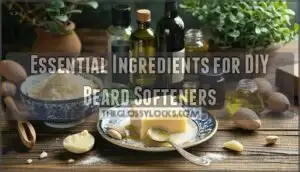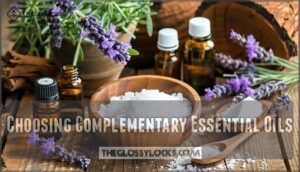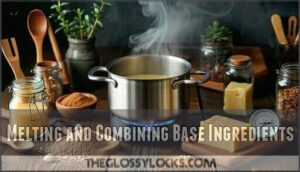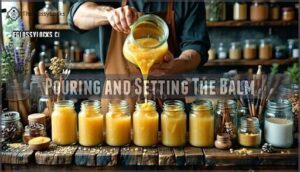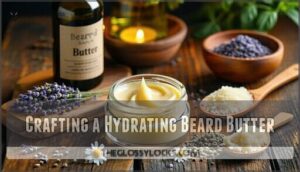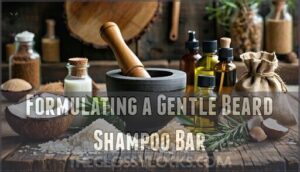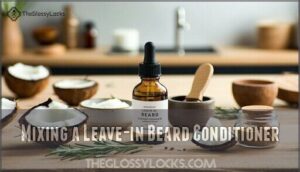This site is supported by our readers. We may earn a commission, at no cost to you, if you purchase through links.
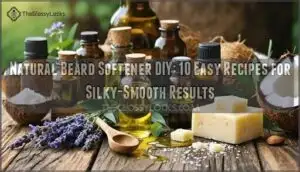 You can easily create a natural beard softener DIY using common household ingredients.
You can easily create a natural beard softener DIY using common household ingredients.
Start with carrier oils like jojoba or coconut oil as your base—they’re your beard’s best friends. Add a few drops of essential oils like cedarwood or lavender for scent and additional benefits.
For extra conditioning power, melt in some shea butter or beeswax. Mix everything together, let it cool, and you’ve got yourself a custom beard softener that’ll make your facial hair softer than a baby’s blanket.
The beauty of making your own is that you control exactly what goes on your face, avoiding harsh chemicals that might irritate sensitive skin. Plus, it’s cheaper than store-bought alternatives and works just as well, if not better, with the added benefit of being a custom solution that is naturally derived and effective.
Table Of Contents
- Key Takeaways
- Benefits of Natural Beard Softeners
- Essential Ingredients for DIY Beard Softeners
- Creating a Basic Beard Oil Recipe
- Whipping Up a Nourishing Beard Balm
- Crafting a Hydrating Beard Butter
- Formulating a Gentle Beard Shampoo Bar
- Mixing a Leave-in Beard Conditioner
- Herbal Infusions for Beard Softening
- Natural Exfoliants for Beard Skin Health
- Dietary Supplements for Softer Beard Growth
- Frequently Asked Questions (FAQs)
- How to make a beard softer at home?
- What is a good substitute for beard conditioner?
- Can vaseline soften a beard?
- How to soften your beard naturally?
- What to put on a beard to make it soft?
- What oil softens beards?
- How can I make my beard soft and straight at home?
- How often should you apply DIY beard softener?
- Are there allergens in DIY beard recipes?
- Can essential oils irritate sensitive skin?
- Conclusion
Key Takeaways
- You’ll create effective beard softeners using common household ingredients like jojoba oil, coconut oil, shea butter, and essential oils – saving money while avoiding harsh chemicals found in commercial products.
- You can customize different formulations (oils, balms, butters, or leave-in conditioners) based on your specific beard type and skin sensitivity, giving you complete control over what touches your face.
- You’ll need to store your DIY creations properly in dark glass containers at cool temperatures to maintain effectiveness for 3-6 months, and always patch-test new ingredients before full application.
- You’ll get better results by combining external treatments with internal nutrition – staying hydrated and consuming omega fatty acids, biotin, and zinc helps create naturally softer beard growth from within.
Benefits of Natural Beard Softeners
Natural beard softeners transform your rough, scratchy facial hair into a smooth, manageable masterpiece that won’t leave your partner running for the hills.
You’ll enjoy complete control over what touches your skin while saving money and avoiding harsh chemicals found in store-bought products.
Improved Beard Texture and Manageability
Your beard transformation starts with natural DIY softeners that target every hair follicle for enhanced texture enhancement.
Your whiskers deserve better than sandpaper—transform them into touchable silk with these DIY beard softeners.
These homemade solutions, featuring jojoba and argan oils, work like magic on stubborn whiskers.
You’ll notice improved beard detangling within days—no more wrestling with knots during your morning routine.
The natural beard softener DIY approach promotes healthy beard growth while delivering superior beard softening results compared to store-bought products.
Your soft beard tips routine becomes effortless as these organic ingredients penetrate deep into each strand.
The DIY beard conditioner formula creates smoother beard texture that responds beautifully to styling.
With consistent use of these softening tips, you’ll achieve that coveted silky finish that makes grooming a pleasure rather than a chore.
Reduced Itching and Irritation
Nothing ruins a good beard day quite like relentless itchiness driving you up the wall. Natural beard softener DIY recipes tackle this head-on with soothing ingredients that calm irritated skin and soften coarse hairs.
Transform rough, scratchy whiskers into touchable softness with natural DIY beard care that actually works.
These gentle formulas reduce inflammation while moisturizing dry patches underneath your whiskers.
Here’s how DIY beard care recipes deliver itch relief:
- Skin soothing oils like jojoba penetrate deep to heal irritated follicles
- Irritation reduction through natural anti-inflammatory compounds that calm angry skin
- Beard calming properties that soften sharp hair edges before they scratch
- Sensitive skin protection with gentle, chemical-free ingredients your face actually loves
- Itchiness relief that lasts all day without greasy residue or harsh additives
Enhanced Beard Health and Appearance
Healthy facial hair starts with proper skin care and quality natural ingredients.
Your natural beard softener DIY recipes deliver essential vitamins and fatty acids that strengthen hair follicles and promote robust hair growth.
These nourishing beard oil recipe blends improve shine while reducing breakage and split ends.
Regular beard softening treatments enhance manageability for effortless beard styling.
Quality DIY beard conditioner formulations boost your beard hygiene routine, creating fuller, more lustrous facial hair that commands attention.
Cost-effective Alternative to Commercial Products
Your bank account will thank you for switching to DIY beard softener recipes.
Commercial products cost $15-30 per bottle, while homemade versions run just $3-5 for the same amount. You’ll control quality and customize scents without premium pricing.
Here’s how DIY savings add up:
- Bulk ingredient purchases reduce per-use costs substantially
- Natural ingredients like jojoba oil serve multiple beard care needs
- Homemade recipes eliminate marketing markup and fancy packaging
These budget-friendly, eco alternatives deliver professional results at a fraction of store prices.
Control Over Ingredients for Sensitive Skin
With DIY beard care, you control every ingredient that touches your face.
Skip harsh chemicals and synthetic fragrances that trigger reactions. Create gentle formulas using natural ingredients like jojoba oil and chamomile for sensitive skin.
This natural beard softener DIY approach prevents allergic reactions while addressing different skin types. You’ll craft personalized natural alternatives that soothe rather than irritate your skin.
Essential Ingredients for DIY Beard Softeners
Creating your own beard softener starts with understanding the essential building blocks that transform coarse facial hair into silky smoothness.
You’ll need carrier oils like jojoba and argan for deep hydration, natural butters such as shea for conditioning, essential oils for fragrance and benefits, plus beeswax and vitamin E to complete your softening arsenal.
Carrier Oils (jojoba, Argan, Coconut)
Your beard softener’s backbone relies on three carrier oil champions. Jojoba oil mimics your skin’s natural sebum, absorbing quickly without greasiness. Argan oil delivers vitamin E and fatty acids for shine and growth support. Coconut oil penetrates deeply, softening coarse hair while adding protective moisture.
These carrier oils for beard work solo or blended together, creating custom oil benefits that transform scratchy whiskers into touchable softness.
For ideal results, consider using high-quality beard care products to enhance your beard’s health and appearance.
Essential Oils (cedarwood, Peppermint, Lavender)
You’ll discover that essential oils transform your natural beard softener DIY from basic to brilliant.
Cedarwood oil brings woody sophistication while potentially stimulating hair growth. Peppermint oil delivers invigorating tingles that awaken follicles and boost circulation. Lavender oil soothes irritated skin with gentle fragrance options.
Here’s your essential oil arsenal:
- Cedarwood oil – Promotes hair growth and adds masculine aroma therapy
- Peppermint oil – Stimulates circulation with cooling skin soothing properties
- Lavender oil – Calms inflammation while providing relaxing fragrance
- Tea tree oil – Fights bacteria with natural antiseptic oil benefits
Natural Butters (shea, Cocoa)
While essential oils add fragrance, natural butters bring deep moisturizing power to your natural beard softener DIY.
Shea butter delivers exceptional skin nourishment and softening properties, while cocoa butter provides rich hydration and promotes healthy growth.
These natural moisturizers create perfect butter blends for DIY beard conditioner recipes.
Mix them with carrier oils for balanced texture that won’t leave you greasy but keeps whiskers incredibly soft.
Beeswax for Hold and Texture
While natural butters provide deep moisturizing, beeswax brings structure to your beard game.
This golden ingredient offers natural hold without the crunch of synthetic products, letting you shape and tame unruly whiskers.
Beeswax Benefits for your natural beard softener DIY:
- Creates flexible hold that moves with your face
- Seals moisture into hair shafts for lasting softness
- Adds natural shine without looking greasy
Perfect for any beard softener recipe requiring texture control.
Vitamin E for Nourishment
Think of vitamin E oil as your beard’s personal bodyguard—it fights off damage while boosting beard growth.
This powerhouse antioxidant strengthens hair follicles and soothes skin underneath.
You’ll get the best hair nourishment by mixing vitamin E oil with carrier oils in your DIY beard conditioner.
Just a few drops deliver serious antioxidant properties for healthier whiskers.
Creating a Basic Beard Oil Recipe
You’ll create a nourishing beard oil by combining carrier oils with essential oils in the right proportions.
This simple recipe forms the foundation of your natural beard care routine and takes just minutes to prepare.
Selecting The Right Carrier Oil Blend
Your carrier oil blend forms the backbone of any natural beard softener DIY project.
Jojoba oil mimics your skin’s natural sebum, while argan oil delivers deep moisturizing power.
For oil comparison purposes, consider coconut oil for antimicrobial benefits and sweet almond oil for lighter textures.
Blend ratios matter—start with 70% primary carrier types like jojoba, then add 30% complementary oils.
Test skin compatibility first, as some guys react differently to various oil benefits combinations, including antimicrobial benefits and deep moisturizing power.
Choosing Complementary Essential Oils
The secret to masterful essential oil blends lies in understanding scent profiles and oil pairing.
Cedarwood’s woody warmth complements lavender’s floral calm, while peppermint delivers an energizing kick.
Start with 2-3 aromatic combinations for your natural beard softener DIY.
Tea tree adds antimicrobial benefits to your DIY beard oil.
Remember: fragrance options should enhance, not overpower your beard oil recipe with natural ingredients.
Proper Mixing Ratios for Optimal Results
Perfect ratios make your natural beard softener DIY sing.
Mix 95% carrier oils with 5% essential oils—that’s roughly 30ml jojoba/argan blend with 12-15 drops of cedarwood or peppermint.
This Oil Blending formula prevents irritation while maximizing softness.
For Blend Consistency, combine multiple carrier oils in equal parts.
These Ingredient Proportions deliver salon-quality results every time.
Storage and Shelf Life Considerations
Once you’ve mixed your perfect beard oil blend, proper storage becomes your best friend for maintaining freshness. Your homemade creation can last 6-12 months with smart storage choices.
Here’s how to keep your beard oil at peak performance:
- Cool Storage in a dark cabinet or refrigerator prevents rancidity and extends shelf life substantially
- Container Selection matters—choose amber or cobalt glass bottles to block harmful UV rays that break down oils
- Product Stability improves when you label bottles with expiration dates based on your shortest-lived ingredient
Proper beard oil storage techniques are essential for maintaining the quality of your homemade beard oil. Check your oil monthly for any off smells or color changes that signal it’s time for a fresh batch.
Application Techniques for Maximum Benefit
Now you’ll apply your natural beard softener DIY masterpiece.
Start with clean, damp facial hair for ideal beard oil application.
Place 3-4 drops in your palm, rub hands together, then work through your beard using beard massage techniques.
Focus on skin nourishment beneath the hair, then use beard combing for even hair distribution.
This DIY beard softener transforms rough whiskers into silk.
Whipping Up a Nourishing Beard Balm
Beard balm combines the moisturizing power of oils with the styling hold of beeswax, creating a versatile product that’ll tame even the wildest whiskers.
You’ll melt base ingredients like shea butter and beeswax together, then add your favorite essential oils for a custom scent that won’t make your significant other flee the room.
Melting and Combining Base Ingredients
Melt your beeswax, shea butter, and cocoa butter using these proven mixing techniques:
- Set up a double boiler with gentle, consistent heat
- Add ingredients based on their melting points – beeswax first, then butters
- Monitor ingredient ratios carefully for proper texture control
- Stir constantly until you achieve smooth base oil blends
This natural beard softener DIY foundation creates the perfect canvas for your DIY beard conditioner.
Incorporating Essential Oils for Fragrance
Now you’ll transform your balm from bland to brilliant.
Essential Oil Blends create signature scents that reflect your style. Mix complementary Fragrance Options like cedarwood and bergamot for woodsy appeal, or peppermint and eucalyptus for fresh vibes.
These Scent Choices offer Aroma Therapy benefits beyond fragrance.
Essential oils for beard enhancement:
- Woodsy blends – Cedarwood, sandalwood, pine for masculine appeal
- Fresh combinations – Peppermint, eucalyptus, tea tree for cooling sensation
- Citrus options – Orange, lemon, bergamot for energizing morning routine
- Spicy mixtures – Cinnamon, clove, ginger for warm, sophisticated scent
Achieving The Right Consistency
Getting your beard balm consistency right requires patience and practice.
After incorporating essential oils, you’ll need to master texture control through proper oil ratios and cooling methods.
Too much beeswax creates a stiff product, while too little leaves it greasy.
Test your mixture’s thickness by dropping a small amount on a cool surface – it should hold its shape but spread easily when warmed with the right consistency.
Pouring and Setting The Balm
Once your balm consistency is perfect, it’s time for the final steps. Work quickly since your natural beard softener DIY will start setting as it cools.
- Pour into containers while mixture is still warm and fluid
- Tap containers gently to release air bubbles and make certain of smooth balm texture
- Allow cooling process at room temperature for 30-45 minutes setting time
- Test consistency by pressing gently – properly set DIY beard balm should hold its shape
Your pouring techniques matter here. Fill containers slowly to avoid creating air pockets in your diy beard products.
Usage Tips for Different Beard Types
Now that your balm’s ready, match it to your specific beard needs for best results.
Different beard types require customized approaches.
Your beard length and skin type determine how much natural beard softener DIY you’ll need:
- Short beards: Quarter-sized amount prevents overwhelming sparse growth
- Medium beards: Walnut-sized portion guarantees even beard texture coverage
- Thick beards: Liberal application tames coarse hair effectively
- Sensitive skin: Light touch with gentle natural ingredients works best
Your growth stage affects absorption rates, so adjust accordingly for superior maintenance tips.
Crafting a Hydrating Beard Butter
You’ll create a luxurious beard butter that feels like whipped cream and delivers deep moisture to both your beard and the skin underneath.
This rich, creamy conditioner combines the best of natural butters and oils to transform even the scratchiest beard into a soft, manageable masterpiece.
Whipping Butters for a Creamy Texture
Whipping shea or mango butter transforms your natural beard softener DIY into silky perfection.
Your electric mixer becomes magic—whipped shea creates creamy texture that melts beautifully into facial hair.
Natural emollients deliver softening properties through proper butter blending.
| Tool Type | Best Butter | Whipping Time |
|---|---|---|
| Stand Mixer | Shea Butter | 3-5 minutes |
| Hand Mixer | Mango Butter | 5-7 minutes |
| Manual Whisk | Cocoa Butter | 8-10 minutes |
Adding Oils for Extra Moisture
With your creamy beard butter base ready, it’s time to boost Moisture Levels through smart Oil Blending.
Add jojoba oil for lightweight Beard Hydration, argan oil for deep conditioning, and fractionated coconut oil for smooth absorption.
Start with equal parts of each natural ingredients and adjust based on your beard’s needs.
This diy beard softener combo delivers unbeatable Oil Benefits and Softening Tips for your natural beard oil creation.
Customizing Scents With Essential Oils
Once you’ve blended moisturizing oils into your beard butter, it’s time to craft your signature scent.
Essential Oil Blends like cedarwood-lavender create woodsy Scent Profiles, while bergamot-vanilla offers fresh Fragrance Layers.
These Oil Combinations provide Aroma Therapy benefits beyond fragrance.
Your natural beard softener DIY becomes uniquely yours through creative essential oils for beard experimentation.
Proper Storage to Maintain Consistency
Your natural beard softener DIY needs proper storage to stay smooth and effective. Temperature swings can turn your creamy butter into a lumpy mess, so consistency matters.
Store your beard balm DIY correctly with these storage tips:
- Airtight containers prevent oxidation and contamination
- Cool storage areas maintain texture and prevent melting
- Dark bottles protect ingredients from light damage
Check your DIY beard conditioner monthly for changes in smell or texture. Proper beard care storage extends shelf life up to six months, keeping your beard oil storage tips working perfectly.
Application Methods for Maximum Hydration
Now that your beard butter maintains perfect consistency, proper application reveals maximum hydration.
Start with a clean, damp beard. Scoop a pea-sized amount and warm between palms. Apply using gentle beard massage techniques from roots to tips.
Follow with beard combing to distribute evenly. This leave-in method guarantees your natural beard softener DIY delivers softener application results that last all day.
For superior results, understanding beard butter benefits is essential to achieve a healthy and silky-smooth beard.
Formulating a Gentle Beard Shampoo Bar
You’ll love making your own shampoo bars because they’re gentle on your beard while keeping it clean and soft.
These solid bars combine mild cleansing agents with nourishing oils, creating a travel-friendly alternative that won’t strip your beard’s natural moisture, making them a great option for travel-friendly use.
Choosing Mild, Natural Cleansing Agents
After crafting your hydrating beard butter, you’ll want Gentle Cleansers that won’t strip away your hard work.
Natural Soaps like decyl glucoside and coco-glucoside become your best friends here. These DIY beard oil companions maintain your Skin pH around 5.5, keeping everything balanced.
Mild Shampoos with plant-based surfactants clean effectively without the harshness. Your natural beard softener DIY deserves cleansing agents that respect both natural ingredients and your skin’s delicate ecosystem.
Using the right gentle skin cleansers is essential for maintaining healthy skin.
Incorporating Moisturizing Ingredients
Once you’ve chosen your cleansing base, it’s time to boost moisturizer benefits and beard hydration.
Your homemade beard conditioner needs these powerhouse ingredients:
- Shea butter – delivers deep hair softening and skin nourishment
- Jojoba oil – mimics your beard’s natural oils perfectly
- Cocoa butter – locks in moisture for lasting beard softness tips
- Vitamin E – strengthens hair while supporting your natural beard softener DIY goals
These moisturizing champions transform ordinary cleansing into serious natural ingredients therapy.
Adding Essential Oils for Fragrance
Once you’ve incorporated moisturizing ingredients, it’s time to add essential oils for custom Fragrance Options.
These Essential Mixes don’t just smell great—they provide skin-soothing benefits too.
Popular Oil Blends include cedarwood with bergamot for woodsy warmth, or lavender with rosemary for calming Aroma Therapy.
Your Scent Choices transform basic natural beard softener DIY into personalized luxury.
| Essential Oil | Amount |
|---|---|
| Cedarwood | 8 drops |
| Bergamot | 6 drops |
| Lavender | 3 drops |
| Rosemary | 2 drops |
Molding and Curing The Shampoo Bar
Pour your mixture into shampoo bar molds while it’s still warm and pliable. Your homemade beard conditioner needs proper setting time to achieve the right bar hardness for effective use.
- Press mixture firmly into molds to eliminate air bubbles
- Allow 24-48 hours for initial curing times in cool, dry location
- Remove from molds once bars hold their shape without crumbling
Your DIY beard care creation transforms from liquid to solid through this soap making process, creating a natural beard softener DIY that’ll elevate your beard care routine.
Usage Instructions for Beard Cleansing
Your homemade shampoo bar works best with the right technique.
Wet your beard with lukewarm water, then rub the bar directly onto facial hair to create a rich lather.
| Step | Action | Duration |
|---|---|---|
| 1 | Wet beard with lukewarm water | 30 seconds |
| 2 | Apply shampoo bar with gentle massage | 1-2 minutes |
| 3 | Work lather through all hair | 1 minute |
| 4 | Rinse thoroughly until water runs clear | 2 minutes |
Use this natural beard softener DIY approach 2-3 times weekly for ideal beard cleansing results, and apply the shampoo bar with a gentle massage.
Mixing a Leave-in Beard Conditioner
You’ll find that leave-in conditioners work best when they absorb quickly without weighing your beard down like a greasy pizza slice.
The secret lies in choosing lightweight oils and water-based ingredients that penetrate hair shafts rather than sitting on top like an unwelcome house guest, which helps to achieve a balanced beard care routine.
Selecting Lightweight, Non-greasy Ingredients
With lightweight beard care, you’ll want ingredients that absorb quickly without leaving residue.
Smart oil selection makes all the difference for comfortable daily wear.
Top lightweight options:
- Jojoba oil – mimics natural sebum and absorbs completely into beard hair
- Fractionated coconut oil – stays liquid at room temperature with zero greasy feel
- Grapeseed oil – budget-friendly option that won’t weigh down fine beard types
Perfect ingredient ratios and natural emollients create product texture that works.
Blending for Smooth Application
Once you’ve selected your lightweight ingredients, achieving the perfect blend becomes your next mission.
Start with a basic 3:1 oil ratio – three parts carrier oil to one part conditioning agent.
This foundation prevents that dreaded greasy aftermath nobody wants.
Your mixing tools matter more than you’d think.
A small whisk works wonders for natural beard softener DIY projects, while an electric milk frother creates professional-grade softener textures in seconds.
Think of it like making the perfect cup of coffee – technique makes all the difference.
Blend techniques should follow the "slow and steady" approach.
Add your beard oil recipe components gradually, whisking between each addition.
This prevents separation and guarantees smooth application methods that won’t leave your beard looking like an oil slick.
Temperature plays a role too.
Room temperature ingredients blend easier than cold ones, creating consistent DIY beard softener results every time.
Your natural beard care tips arsenal isn’t complete without mastering these beard softening tips fundamentals.
Adding Hair-strengthening Components
Now it’s time to fortify your natural beard softener DIY with powerhouse ingredients that’ll transform weak whiskers into warrior-worthy facial hair.
Here’s your hair-strengthening arsenal:
- Vitamin E – penetrates the hair shaft for deep nourishment and static reduction
- Keratin Boost – rebuilds damaged cuticles and adds natural shine
- Hair Protein complexes – strengthen follicle roots from within
- Beard Fortify oils – enhance follicle strength and reduce breakage
These natural beard care tips work like a gym membership for your facial fuzz, building stronger strands with every application.
Bottling and Storage Considerations
Why settle for plastic when glass bottles protect your DIY beard softener from light and temperature changes?
Choose dark amber or cobalt containers for ideal Storage Conditions. Label each bottle with creation date and ingredients for proper Labeling Tips.
Store in cool, dry places away from sunlight to maximize Shelf Life—typically three months. Airtight seals prevent contamination, keeping your homemade beard care fresh and effective.
Application Techniques for Daily Use
Start your morning care with three pumps of leave-in conditioner warmed between palms.
Work through your beard from roots to tips using gentle beard massage motions.
Follow with beard combing to distribute the natural beard softener DIY evenly.
This daily routine transforms rough whiskers into manageable softness—your DIY beard softener becomes the foundation for all-day comfort and style.
Herbal Infusions for Beard Softening
You can enhance your DIY beard softeners by infusing carrier oils with herbs that naturally condition and smooth facial hair.
These herbal-infused oils add therapeutic benefits while creating custom scents that’ll make your beard routine feel like a spa treatment.
Choosing Herbs With Softening Properties
Natural beard softener DIY starts with the right herbs. Marshmallow root’s mucilage creates a conditioning layer that locks moisture into coarse beard hair. You’ll find calendula and chamomile perfect for sensitive skin, while hibiscus breaks down rough cuticles for silkier strands.
These herbal remedies offer botanical oils that outperform synthetic alternatives. When selecting herbs for your homemade recipes, consider your beard’s specific needs:
- Marshmallow root – Best for wiry, coarse textures needing extra conditioning
- Calendula petals – Soothes irritated skin with anti-inflammatory properties
- Hibiscus flowers – Adds shine and softness through natural amino acids
- Aloe vera – Provides gentle daily hydration for all beard types
These natural softeners create effective herbal infusions when properly combined with essential oils. Each herb brings unique softening properties that’ll transform your beard care routine.
Infusing Oils With Selected Herbs
Now that you’ve picked your herbs, it’s time to merge them with oils using proven infusion methods.
Heat infusion works faster—gently warm your carrier oil with herbs for 2-3 hours. Cold infusion takes patience but preserves delicate compounds. Simply combine herbs and oil, then wait 2-4 weeks.
| Oil Types | Best Herbs | Infusion Time | Heat Level | Benefits |
|---|---|---|---|---|
| Jojoba | Rosemary, lavender | 2-3 hours | Low heat | Deep conditioning |
| Argan | Chamomile, mint | 3-4 weeks | Room temp | Softening power |
| Coconut | Nettle, horsetail | 2 hours | Gentle heat | Shine enhancement |
| Sweet almond | Calendula, sage | 2-4 weeks | Cold method | Skin soothing |
| Olive | Thyme, oregano | 1-2 hours | Medium heat | Antimicrobial |
Your homemade recipes will benefit from proper herb selection and storage techniques for maximum nourishing oils potential.
Straining and Storing Infused Oils
Clarity emerges when you strain your herbal-infused carrier oils through cheesecloth or fine mesh sieves, removing plant debris that could spoil your beard oil.
Store filtered oils in dark glass containers with tight lids, maintaining temperature control below 70°F.
Label each container with ingredients and date—proper labeling practices extend shelf life to six months while preserving those precious herbal infusions.
Incorporating Into Beard Care Recipes
Now you can seamlessly blend your herbal oil infusion into any DIY beard softener recipe.
Simply substitute 25-30% of your base carrier oils with infused versions. Your jojoba oil or argan oil infusions work perfectly in natural recipes, enhancing balm consistency and butter hydration.
A boar bristle brush can help with even oil distribution.
Whether you’re crafting a DIY beard conditioner or perfecting conditioner blending, these botanical powerhouses elevate ordinary formulations into extraordinary beard-taming creations.
Benefits of Different Herbal Combinations
Through smart herbal synergy, you’ll discover powerful combinations that transform your DIY beard softener.
Rosemary and nettle boost hair strength while chamomile soothes scalp health.
These infusion methods create unique scent profiles – lavender-mint refreshes, while cedarwood-sage adds earthy warmth.
Essential oils amplify these herbal infusions, delivering serious natural beard care benefits and DIY beard care advantages.
Natural Exfoliants for Beard Skin Health
Healthy beard skin underneath your whiskers needs regular exfoliation to prevent buildup and irritation that can make your beard feel rough and scratchy.
Natural exfoliants gently remove dead skin cells and unclog pores while keeping your skin moisturized for better beard growth.
Gentle Scrub Ingredients for Beard Area
Your beard area deserves gentle care, not sandpaper treatment.
Natural exfoliants remove dead skin without harsh chemicals, revealing softer skin underneath.
- Sugar scrubs dissolve easily while buffing away buildup
- Oatmeal benefits include soothing irritated skin naturally
- Coffee grounds provide antioxidants plus gentle scrubbing action
Salt scrubs work too, but go easy—your face isn’t a sidewalk.
Clay masks draw out impurities between scrub sessions for complete natural beard care.
Mixing Exfoliants With Moisturizing Agents
Perfect exfoliants need moisturizing partners to prevent irritation.
Mix brown sugar with jojoba oil or coconut oil at a 2:1 ratio for gentle scrubbing power.
Shea butter softens rough particles while delivering moisturizing ingredients your skin craves.
This combo maximizes exfoliation benefits without the harshness, creating the perfect foundation for your DIY beard conditioner routine.
Application and Massage Techniques
Gentle circular motions release your beard’s potential when applying exfoliants.
Start with damp skin, then follow these steps:
- Light pressure application: Use fingertips to massage exfoliant in circular motions around pressure points
- Tool assistance option: Try a soft brush for deeper penetration and better absorption time
- Post-application care: Rinse thoroughly, then apply beard oil application, beard balm application, or beard butter application to soften beard hair
This beard massage routine enhances product effectiveness.
Frequency of Use for Optimal Results
Ideal frequency for natural exfoliants is 1-2 times weekly—never daily application since over-conditioning risks irritation.
Your skin needs recovery time between treatments. Consider seasonal adjustments: winter requires less frequent use than summer.
When product layering with softening beard products like DIY beard balm or homemade beard conditioner, reduce exfoliation to once weekly. This effective beard softener routine prevents damage while maximizing benefits and is a good way to maintain a healthy beard with natural exfoliants.
Post-exfoliation Care for Beard and Skin
Follow up exfoliation with immediate hydration methods to lock in moisture and prevent irritation.
Apply soothing balms containing jojoba oil or argan oil while your skin’s still damp—this boosts oil absorption and maximizes benefits.
Coconut oil mixed with shea butter creates an excellent post-scrub treatment that tackles redness reduction head-on.
The combo also supports ingrown prevention by keeping follicles clear and moisturized.
Biotin helps keratin production for thicker hair.
Your freshly exfoliated skin drinks up these natural ingredients like a thirsty plant, leaving your beard area soft and comfortable.
Dietary Supplements for Softer Beard Growth
While external beard care products work wonders, nourishing your beard from the inside out creates the foundation for truly soft, manageable facial hair.
The right combination of vitamins, minerals, and nutrients can transform your beard’s texture and growth quality, giving you that coveted softness that no amount of oil can fake.
Essential Vitamins for Beard Health
Your beard’s health starts from within, and targeted vitamins can transform stubble into silky perfection.
Biotin benefits include stronger keratin production for thicker strands, while Vitamin D activates dormant follicles for natural beard growth.
Zinc intake supports overall hair structure and reduces breakage.
- Biotin (2.5mg daily) – Strengthens beard vitamins absorption and keratin formation
- Vitamin D (600 IU) – Activates follicles and promotes healthy fats utilization
- Zinc – Enhances collagen peptides production for resilient growth
Minerals That Promote Softer Hair
Your body naturally requires specific minerals for effective beard softener results.
Zinc benefits include strengthening hair follicles, while iron absorption boosts circulation to facial hair.
Copper intake supports collagen production for improved beard texture, and magnesium effects enhance beard manageability.
Selenium sources like Brazil nuts protect against oxidative damage.
These minerals create the foundation for natural beard softening and beard softness.
Omega Fatty Acids for Beard Nourishment
Boost your beard’s natural softness by embracing omega fatty acids—your facial hair’s best friend.
These nourishing oils work from within, transforming coarse whiskers into silky strands.
Fatty acid types like omega-3s (found in salmon, walnuts, flaxseeds) and omega-6s (sunflower seeds, hemp oil) deliver targeted beard nourishment when you maintain proper balance.
Dietary sources offer superior absorption methods compared to synthetic alternatives.
If whole foods aren’t cutting it, supplement options like fish oil capsules provide concentrated omega benefits.
The anagen phase duration impacts hair thickness.
Your beard oil routine works better when you’re feeding follicles internally too—think of it as premium fuel for premium beard health results.
Protein-rich Foods for Stronger Growth
While omega fatty acids fuel your beard’s foundation, protein sources create the actual building blocks.
Your beard needs quality amino acids to craft strong keratin strands that resist breakage and feel softer.
Consider these nutrition powerhouses for ideal beard health:
- Lean meats and fish – Salmon and chicken deliver complete proteins plus growth factors
- Eggs and dairy – Greek yogurt provides biotin alongside essential amino acids
- Plant proteins – Lentils and quinoa offer beard protein without the saturated fat overload
Smart dietary supplements can fill gaps, but whole foods trump pills for beard growth.
Adequate intake of collagen boosts follicle health.
Your whiskers will thank you.
Hydration’s Role in Beard Softness
Your beard craves Water Intake like a desert needs rain. Proper Hydration Methods enhance Product Absorption of beard oil and homemade beard conditioner.
Environmental Factors steal moisture, making Humectant Benefits vital for beard hydration.
| Hydration Level | Beard Feel | Daily Water Goal | Product Tips | Softness Score |
|---|---|---|---|---|
| Dehydrated | Scratchy wire | 4-6 glasses | Poor absorption | 2/10 |
| Low hydration | Rough patches | 6-8 glasses | Needs more oil | 4/10 |
| Adequate | Manageable | 8-10 glasses | DIY beard conditioner works | 7/10 |
| Well-hydrated | Soft strands | 10+ glasses | Perfect absorption | 9/10 |
| Ideal | Silky smooth | 12+ glasses | Minimal product needed | 10/10 |
Frequently Asked Questions (FAQs)
How to make a beard softer at home?
Mix jojoba oil, shea butter, and coconut oil to create your own conditioning blend.
Apply it to clean, damp facial hair and massage into skin underneath.
This natural combo moisturizes effectively.
What is a good substitute for beard conditioner?
Ninety percent of men report beard irritation from harsh chemicals.
You can substitute regular hair conditioner, coconut oil, or shea butter for beard conditioner.
These alternatives moisturize effectively and cost less than specialized products.
Can vaseline soften a beard?
Vaseline can temporarily soften your beard by trapping moisture, but it’s heavy, greasy, and doesn’t absorb well.
You’ll get better results with natural oils like jojoba or argan that actually nourish hair.
How to soften your beard naturally?
Apply natural oils like jojoba, argan, or coconut directly to your clean, damp beard.
Massage thoroughly from root to tip, including the skin beneath.
Regular conditioning prevents dryness and keeps facial hair manageable.
What to put on a beard to make it soft?
Like a thirsty plant drinking water, your beard craves moisture. Use beard oil with jojoba or argan oils, or apply natural conditioners containing shea butter and coconut oil daily.
What oil softens beards?
Jojoba oil’s your best bet—it mimics your skin’s natural sebum, softening coarse hairs without clogging pores. Argan and sweet almond oils also work wonders for taming stubborn whiskers.
How can I make my beard soft and straight at home?
Patience yields results—you’ll tame that wild mane with consistency.
Create a DIY beard softener using jojoba oil, shea butter, and argan oil.
Apply daily, comb through while damp, and brush regularly to train hairs straight, which will help you achieve results.
How often should you apply DIY beard softener?
You should apply DIY beard softener daily, ideally after washing your face in the morning. Start with a small amount—too much creates greasiness that’ll weigh your whiskers down.
Are there allergens in DIY beard recipes?
Yes, DIY beard recipes can contain allergens.
Tree nuts like sweet almond oil, coconut oil for those with coconut allergies, and essential oils may trigger reactions.
You’ll want to patch-test new ingredients before applying them to your entire beard to ensure safety, as this can help prevent allergic reactions.
Can essential oils irritate sensitive skin?
Like a lit match near dry kindling, essential oils can spark irritation on sensitive skin.
They’re highly concentrated compounds that penetrate deep, potentially causing redness, burning, or rashes—especially undiluted ones.
Conclusion
Mastering multiple natural beard softener DIY recipes transforms your grooming routine completely.
You’ll discover that creating custom formulations saves money while delivering superior results compared to commercial alternatives.
Your beard deserves personalized care using pure, natural ingredients that work specifically for your skin type.
Whether you prefer oils, balms, or butters, these recipes guarantee your facial hair stays soft, manageable, and healthy.
Start experimenting with these natural beard softener DIY solutions today for consistently impressive results.

